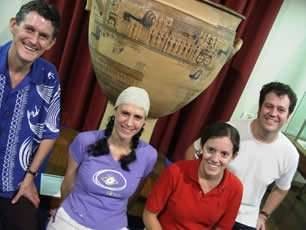Lita Poulos - member - Australian Paliochora-Kythera Archaeological Survey - Education Officer - Nicholson Museum, Sydney University
Lita is the daughter of John Poulos (Tzortzopoulos) - parachoukli - Sihanouli - now residing in Karavas, Kythera.
John was instrumental in renovating (recently) the old Agricultural College building in Karavas, where members of Australian Paliochora-Kythera Archaeological Survey reside, when involved on "digs".
Education Officers:
Lita Diacopoulos, second from left, amongst fellow Education Officers at the Nicholson Museum Sydney University:
Michael Turner
Guadalupe Cincunegui
Craig Barker

The Nicholson Museum
A14
University of Sydney
NSW 2006
Tel +61-2-9351 2812
Fax +61-2-9351 4889
mailto:dan.potts@archaeology.usyd.edu.au
Opening Hours
10.00 AM-4.30 PM Monday to Friday.
Closed on public holidays.
Admission is free.
The Nicholson Museum is located at the southern entrance of the Main Quadrangle, on the Camperdown campus.
To obtain map, click on,
http://www.usyd.edu.au/nicholson/map.html
For Staff Registry, Nicholson Museum, go to:
http://www.usyd.edu.au/nicholson/staff.html
The Nicholson Museum at the University of Sydney contains a diverse collection of material from Egypt, the Near East, Greece, Italy and northern Europe. It is Australia’s largest public collection of artefacts from the ancient world.
The Nicholson Museum School Education Program (SEP) is available to groups of school students from Years 1-12 and offers a particularly strong program designed to
complement the newly introduced NSW Ancient History Syllabus.
See, http://www.usyd.edu.au/nicholson/pdf/school_education03.pdf
The program emphasises the analytical and interpretative processes of archaeological investigation, demonstrating the ways students can use archaeological evidence in theirstudy of ancient societies.
The program caters to a wide range of HSC options and provides students with an overview of Egyptian, Near Eastern, Greek, Roman and Celtic cultures according to their requirements. It places a great emphasis on class group discussions and hope to engage students via reference to objects that relate to particular issues in the past.
It also provide detailed analysis and discussion of topics such as artistic development, funerary customs, religious practices, the role of women in ancient societies and daily life in these cultures.
An important component of the program is the hands-on session where students handle genuine museum objects to gain an understanding of how archaeological evidence can be used to illuminate an ancient society. Topics covered by the program include interpreting a hypothetical archaeological excavation with authentic artefacts, an illustrated talk covering work on a dig, and presenting reports on museum objects.
Archaeological methods and techniques can be examined, as can questions about the ethics of archaeology, the collection and display of artefacts, and studies of how a museum operates. The program is taught by qualified archaeologists with extensive fieldwork and research experience, who assist students in developing their skills of analysis, interpretation and understanding of ancient cultures.